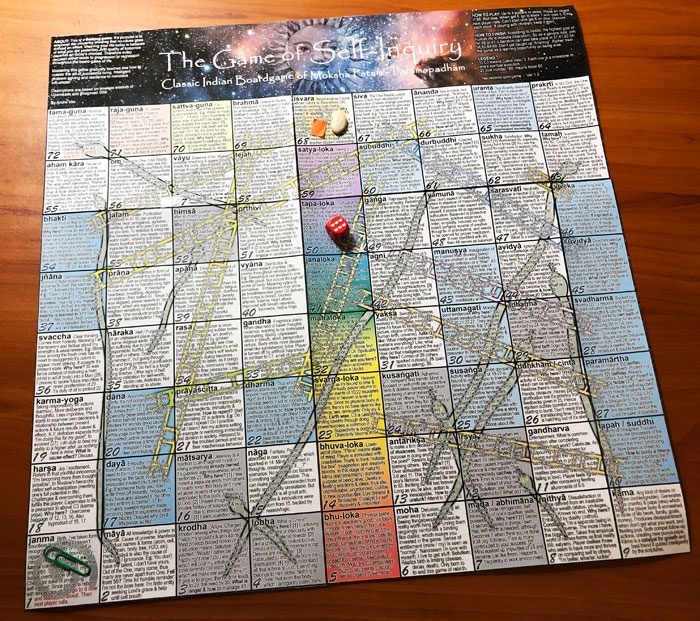“ Play for Wisdom, Win for Enlightenment.
Moksha Patam is an Ancient Game of the Rishis That Helps You Integrate the Knowledge of Yoga, Upanishads & Bhagavad Gita. It Teaches Years of Practical Wisdom in a Single Game. ”
Other names of the game: Snakes and Ladders, Paramapadham, Gyan Chauper, Parama Padam, Vaikuntapali. More on Wikipedia.
Download, Print & Play
Print the 5 PDF files. Then cut out and sticky tape together. Total size will be about 18 x 18 inch OR 43.7 x 43.7 cm.
Current ver: 2.5
Actually you, the player, have been playing this game since the beginning.
Only this time we get to see how each decision leads to our loss or gain in context of becoming wise.
Being given capacity to make choices, the game shows us our experience and perception of the world is a consequence of our thoughts and decisions we're entertaining on a daily bases.
But what determines the quality, texture and flavor of our thoughts and decisions? Knowledge.
An informed decision is only as good as what you know or don't know right now.
Purpose of this game is to inform the player. To help him or her understand oneself deeply. To answer why some fall (pātam पातम्) and some rise (mokṣa मोक्ष). Why some remove ignorance (mokṣa) and others reinforce it (pātam).
You might consider playing the game just once. Noticing how quickly it can teach insights into realities.




Thank you, this is amazing!
Hari Om i have tried to download the game but the “download” button function is not responding at all – it looks like a awesome one though:) THANKS
i have tried to download the game but the “download” button function is not responding at all – it looks like a awesome one though:) THANKS
THANK you Andre:)
Just to let others know : the link works for me only without the initial ” http:// ” (otherwise the direct download link keeps not responding).
How to start the game and continue to play?
there are 5 boards
which board for what
playing instructions for each board
and how to come to a conclusion
Adhi, please see above tab: “Download & Print” for instructions.
Also tab: How to Play
I’ve just downloaded the file. I’m confused because I imagined there to be 100 squares as this is the measure of liberation so I read. Also the instructions on the print out refers to 68 and there’s only 64 squares. As I missing other pieces, is there more to download. Also when I set it to print on my PC a attached to my printed the print viewing screen only shows 85% of the full image. I’ve downloaded the file to my I pad to see / read the squares. Curious about the names / title of each square in English. Lots of questions. I’m excited to get started but these are the issues stoping me. Thanks you for this works it’s beautiful. Hoping someone can answer my question and points. Gratitude
Total is 72 blocks as per: https://tinyurl.com/3jm53umd
Simply stick together the A4 sheets, and they should be same as above picture.
I have recently become fascinated since reading more about the origins of “snakes and ladders” game concept. Now I’m curious to learn the literal translation from Hindi (?) to English of ‘moksha patam’.
I understand that ‘moksha’ means something like “liberation from rebirth” but I can’t find the direct and/or deeper meaning of ‘patam’. It doesn’t help when some websites state that mokshapatam means Snakes and Ladders!
Please – can someone just explain that word?
I already understand the English interpretation relates to the visual metaphors depicted in Gyan chauper — the ladder, symbolising a climb or ascension to the higher plane, with the snake hugely over-simplified by the British. In a Christian context it symbolises “deceit” and is associated with a “fall from grace” as depicted in the Adam-Eve story. In other cultures though ‘snake’ symbolism is quite enigmatic — concepts of transformation, regeneration, fertility, rebirth…
(I’m neither christian nor hindi… not religious, just curious and would love to play Gyan Chauper or make my own version too).
mokṣa (मोक्ष) : Highest goal of human life.
patam (पतम् ) (mas) : (1) Falling (2) flying.
Thus “Falling from the highest goal of human life”. That’s why whole game is about showing the individual the consequences of remaining fallen (ignorant) in the cycle of rebirth (saṃsāra).
However patam also means “flying”. Thus: Flying (going) to the highest goal of human life.
Hence “mokṣa patam” is an ideal name because journey isn’t only about falling (going down), but also flying to (going up).
Andre, thank you. I like that it also means “flying” — it inspires some interesting visuals for me. Sorry it took so long to acknowledge – a few “ladders” got in the way (work and new puppy). Not exactly “falling” but life is full of such “sidetracks”. Hmm…. I wonder if diversions and distractions ever feature in the concept.
Falling: regression in life (by making informed choices).
Flying: growth/progression in life (by making wise decisions).
Hi! I came across this when studying the history of Snakes and Ladders. I am interested in seeing which original source of this version that has been well translated. Would you mind putting an image of the original version up as well?
Oh I found the original picture of the 1700 AD 72 square version. I was a bit confused because the linked article for the history only mentioned 100 squares. Upon closer inspection, the photo of the 1700 AD one only has 72 squares, not 100.
Yes, this game is using the 72 blocks from 1700AD ver.
Can someone help with each box key words
Do we mean translating the keyword like block 1 “janma” to “birth”, for example?
IS IT USEFUL IN FINDING PRESENT PROBLEM ONE FACE ,IF YES HOW TO ASK AND HOW SOLUTION IS FIND OUT AS OF HEALER SAY THIS GIVES ANSWER
you guys changed my llife .love you!
I’m pleased to know this Dharmesh.
Hello ~
I played the game yesterday with a host who had played in the past. Before we started I was told to place my left hand over my heart and ask I question I wanted answered.
What are your thoughts on this?
Thank you!
Hi Holly. You may of course. It’s also possible that playing the game might trigger new questions you haven’t thought of before.
Thank you ~
Do you offer classes to master the game to become a host.
Do you know where i can purchase the floor mat sized game?
Thank you Andre!
No. Best way is to just get into it as per video. Important is to read the text in each block and contemplate it’s meaning.
Download template, print on A4, and sticky tape.
If have any suggestions, I’m open to hearing.
Thank you Andre.
Yes, did all this ~
Thank you – I look forward to playing it with my grandkids…